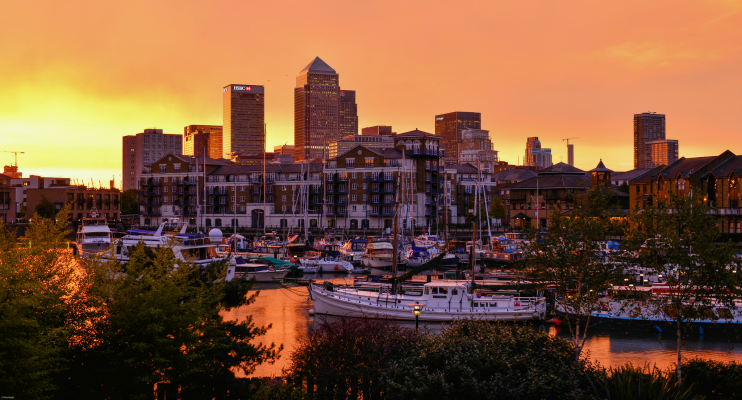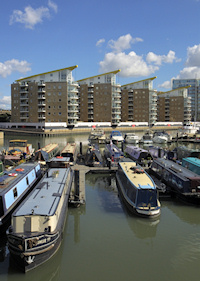Limehouse
Limehouse, Tower Hamlets
Part gentrified, part solidly working-class, this East End district forms the north-western gateway to the Isle of Dogs

Limehouse takes its name from the limekilns that operated from the mid-14th century, converting Kentish chalk into quicklime for the capital’s building industry.
From the late 16th century ships were built at Limehouse and traders supplied provisions for voyages.
Wealthy merchants erected fine houses on Narrow Street, especially in the early 18th century. In 1730 Nicholas Hawksmoor built St Anne’s church just south of Commercial Road. Regarded as one of the architect’s finest works, it has the highest church clock in London.
In the 1740s a short-lived pottery produced England’s first soft-paste porcelain, which was known as Limehouse ware.
London’s oldest canal, the Limehouse Cut, was constructed around 1770 to link the River Lea at Bow with the Thames here, thus saving a journey around the Isle of Dogs.
With the growth of its docks, Limehouse acquired an immigrant population and became London’s first Chinatown. The Chinese community was never very large but it gained a reputation for gambling and opium-smoking and Limehouse provided the backdrop for the Dr Fu Manchu films. Indeed, their creator claimed that the character was modelled on a Chinese man of unusual appearance whom he had glimpsed on Limehouse Causeway one foggy night in 1911.
Despite the 20th-century decline and closure of the London docks, the heart of old Limehouse survived the post-war municipal redevelopment that transformed so much of the East End.

Narrow Street’s houses were some of the first in London to undergo gentrification from the late 1950s and disused warehouses were converted to apartments in the 1970s and 1980s. Private developers have since added new units, some of which were erected with excessive haste to capitalise on the Docklands residential boom.
The Limehouse Link burrowed beneath the locality in the early 1990s, connecting Canary Wharf with the Highway, which leads to the City of London.
In 1994 Half Moon young people’s theatre moved into the former offices of the Limehouse board of works on White Horse Road. To the west, at 490 Commercial Road, the former Troxy cinema hosts concerts, conferences and other events.
Although there are still a few Chinese restaurants in Limehouse, people of Bangladeshi descent now form the largest ethnic minority, followed by white British. The 2011 census recorded only 3.6 per cent of residents of Chinese heritage here. This was an increase on the 2.7 per cent recorded in 2001 but was far lower than nearby Millwall’s 9.0 per cent.
Postal district: E14
Population: 15,986 (2011 census)
Station: c2c; Docklands Light Railway, all branches (zone 2)
Website: Limehouse Project
Further reading: Daniel Farson, Limehouse Days: A Personal Experience of the East End, Michael Joseph, 1991
Selected Limehouse extracts from Brewer’s Dictionary of London Phrase & Fable
In Jewish legend a golem (Yiddish, from Hebrew gōlem, ‘shapeless mass’) is a human figure formed from clay that can be supernaturally endowed with life. They were supposedly used as servants by rabbis. Peter Ackroyd reintroduced the concept of the golem in his novel Dan Leno and the Limehouse Golem (1994), about a series of mysterious murders in 19th-century east London.
In Britain in the early part of the 20th century, to limehouse meant ‘to use coarse abusive language, especially in a political speech’. The usage arose from a notably acerbic speech that the Liberal politician David Lloyd George made in Limehouse on 30 July 1909, in which he attacked the aristocracy, financial magnates, etc.
‘Limehouse Blues’ is a song (1921) telling ‘a story of old Chinatown’, written by Philip Braham and Douglas Furber, made famous by Gertrude Lawrence and subsequently performed by Rosemary Clooney and Julie Andrews. It is now much better known as an instrumental and has been recorded in this form by Duke Ellington, Charlie Parker, Django Reinhardt and many others.
‘Limehouse Cut’ has been used as in the past as cockney rhyming slang for gut, usually with reference to the size of someone’s paunch. (For ‘guts’, plural, Newington Butts is preferred).
The Limehouse declaration was a document setting out the founding principles of the Social Democratic Party, which was established by the Labour Party moderates Roy Jenkins, David Owen, Bill Rodgers and Shirley Williams at Owen’s Narrow Street home in 1981. The SDP merged with the Liberal Party in 1988.
Limehouse Hole was an old name for the riverside district centred on present-day Westferry Circus, on the Isle of Dogs. From the 17th century it was a plying place for watermen and it later became densely filled with shipyards and other dock-related industries.
Limehouse Nights is a collection of short stories (1916) by the prolific Poplar-bred author Thomas Burke (1886–1945). Set in London’s original Chinatown, Limehouse Nights caused controversy for its sympathetic portrayal of aspects of the East End underworld and was banned for immorality by the national subscription libraries. Burke produced several more collections of Limehouse tales (and poetry), often featuring Quong Lee, an elderly Chinese character based on a man he had known in his childhood.
Limehouse Reach is the stretch of the River Thames opposite Limehouse, extending down the western side of the Isle of Dogs.
Lord Love-a-Duck of Limehouse was the title that Clement Attlee (1883–1967), Labour prime minister (1945–51), said he would take should he ever be elevated to the peerage. When Attlee resigned as Labour Party leader in 1955 he actually became 1st Earl Attlee of Walthamstow, Viscount Prestwood.
